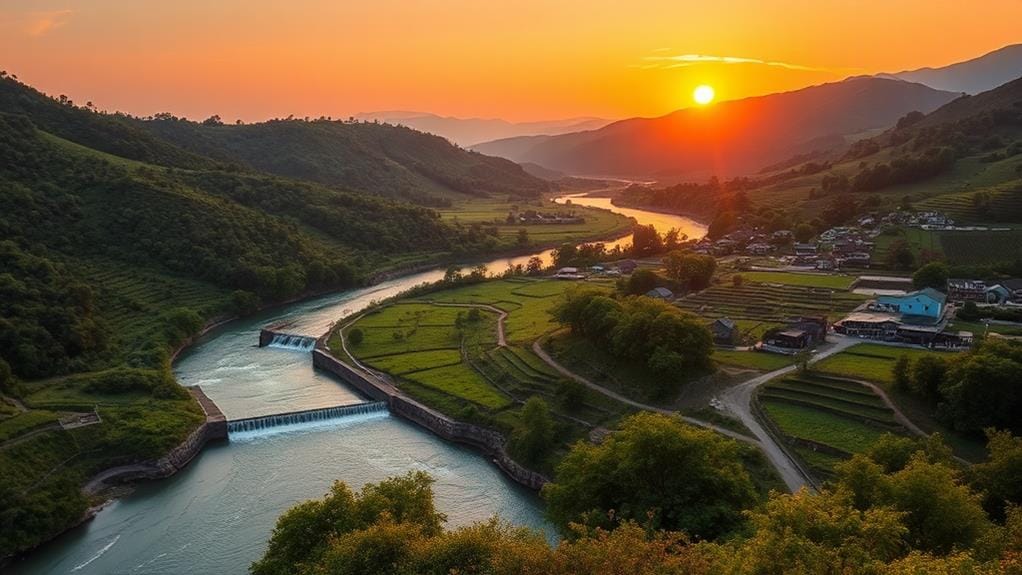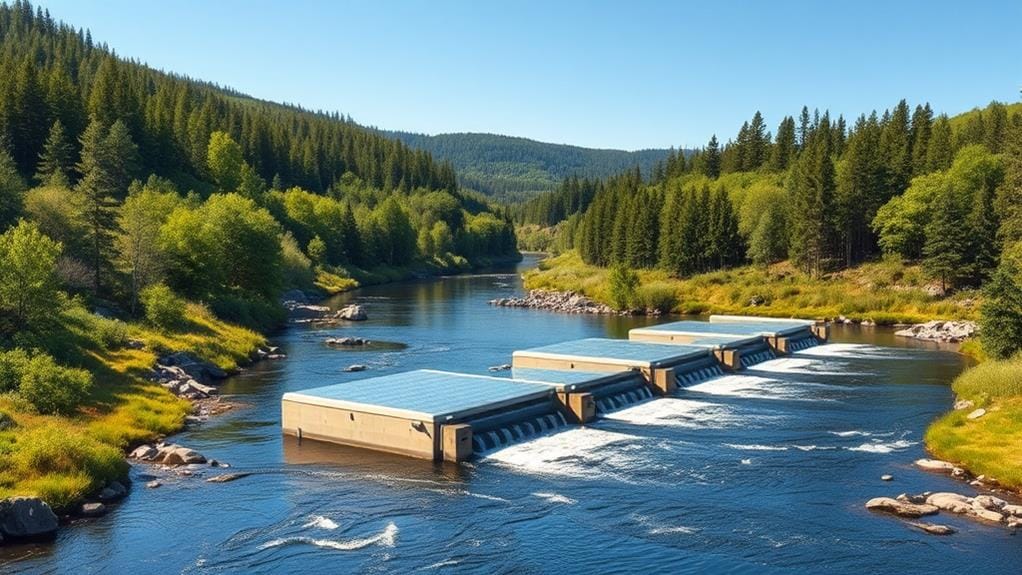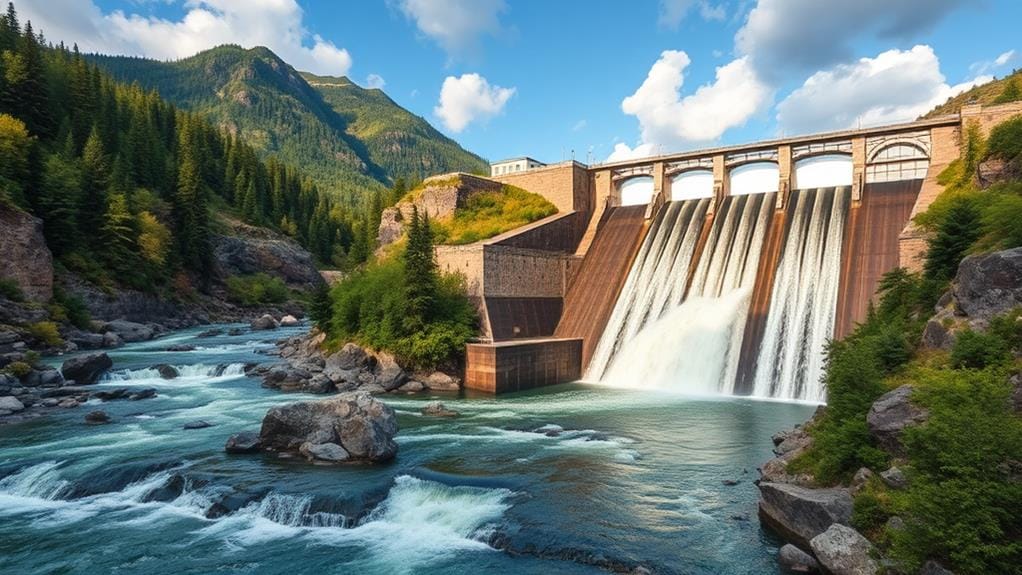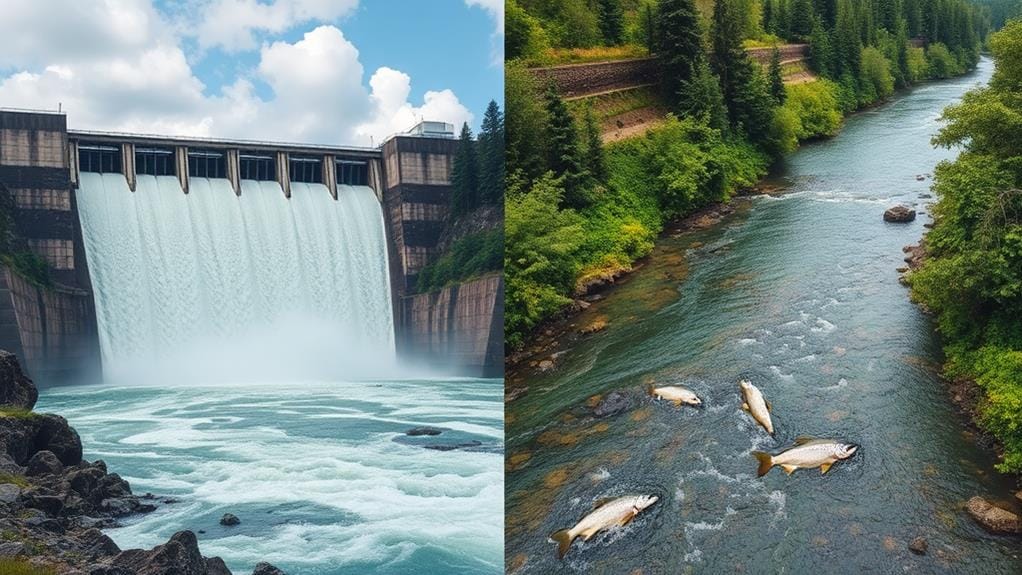When we choose run-of-river hydropower for sustainable energy, we're selecting a system that harnesses the natural flow of rivers, resulting in lower greenhouse gas emissions and diminished environmental impact compared to traditional hydroelectric dams. This method requires considerably less upfront investment and has a quicker construction timeline, allowing for prompt energy generation while minimizing infrastructure demands. Additionally, run-of-river systems foster local job creation—estimated at 53,500 new jobs in the U.S. by 2030—and support community development. By understanding these advantages, we can see how this technology aligns with our goals for a cleaner, more resilient energy future, inviting further exploration into specific applications and innovations.
Key Takeaways
- Run-of-river hydropower has lower greenhouse gas emissions, making it a cleaner alternative to traditional energy sources.
- It requires lower upfront investments and shorter construction times, facilitating quicker project deployment and energy generation.
- The technology enhances grid reliability by providing quick power adjustments and supporting the integration of other renewable sources.
- Job creation in local communities fosters economic growth and resilience through diverse employment opportunities in various sectors.
- Recreational opportunities from clean rivers promote community engagement and boost local tourism through outdoor activities.
Overview of Run-of-River Hydropower
Run-of-river hydropower offers a sustainable alternative to traditional hydroelectric systems by harnessing the natural flow of rivers without the need for large water storage. These systems direct river water through channels or penstocks to turbines, enabling consistent electricity production while minimizing environmental disruptions. With lower construction costs and quicker build times, run-of-river installations can be deployed efficiently compared to larger dams. Although their output may be less than conventional facilities, they remain a reliable energy source, particularly in areas with steady river flows. By promoting local energy self-sufficiency, run-of-river hydropower helps reduce our reliance on fossil fuels, paving the way for a cleaner energy future with minimal environmental impact, aligning our collective commitment to sustainability.
Environmental Benefits

There's no doubt that run-of-river hydropower brings significant environmental benefits. By utilizing the natural flow of rivers without significant storage, these systems minimize environmental disruption and preserve aquatic habitats. The table below highlights key advantages:
| Aspect | Run-of-River Impact | Comparison to Dams |
|---|---|---|
| Greenhouse Gas Emissions | Much lower emissions | Higher emissions |
| Environmental Footprint | Smaller footprint | Larger footprint |
| Aquatic Habitats | Continuous flow supports habitats | Flooding disrupts habitats |
| Biodiversity | Enhances local species diversity | Often decreases biodiversity |
| Infrastructure Requirements | Utilizes existing structures | Requires extensive new infrastructure |
Economic Advantages

As we explore the economic advantages of run-of-river hydropower, it is crucial to recognize that these systems not only require lower upfront investments, but they also foster significant job creation opportunities in local communities. With their streamlined construction processes and minimal infrastructure needs, developers face reduced financial barriers, allowing for quicker project implementation and increased accessibility to renewable energy sources. Additionally, the long-term operational savings associated with run-of-river installations—driven by their extended lifespans and lower maintenance requirements—underscore their viability as a sustainable energy solution.
Job Creation Opportunities
The run-of-river hydropower sector is set to create an estimated 53,500 new jobs by 2030, greatly boosting the U.S. hydropower industry. As we embrace sustainable energy solutions, we find that job creation in run-of-river systems supports local economies, especially in rural areas where these projects are often implemented. These initiatives foster community development and sustainability while offering diverse employment opportunities in fields such as engineering, environmental science, and project management. Additionally, the collaboration with local communities enhances roles in tourism and environmental education, further enriching our neighborhoods. By investing in run-of-river hydropower, we not only lower operational costs but also build a more resilient workforce, ensuring lasting benefits for our communities and the economy as a whole.
Lower Upfront Investments
When considering the economic landscape of renewable energy, run-of-river hydropower stands out for its lower upfront investments. This approach offers several advantages that make it an appealing choice:
- The construction timeline for run-of-river systems is often shorter, enabling quicker deployment.
- They leverage existing infrastructure, such as bridges and weirs, reducing the initial capital required.
- With minimal land acquisition and fewer environmental management needs, overall costs are markedly lowered.
These factors contribute to the economic viability of run-of-river hydropower, as they allow for efficient resource utilization while maintaining competitive operating costs. By minimizing the capital required upfront, we can foster sustainable energy solutions that align with our collective goals for environmental stewardship and economic growth.
Long-Term Operational Savings
Building on the economic benefits of lower upfront investments, long-term operational savings further enhance the appeal of run-of-river hydropower. These systems typically incur lower construction costs due to their minimal need for large reservoirs, which also translates into reduced operational costs. By avoiding significant water management expenses and reservoir maintenance, we're able to achieve financial sustainability over time. Additionally, run-of-river facilities can be constructed more quickly, allowing for earlier energy generation and faster returns on investment. Maintenance costs remain low due to simpler infrastructure and fewer environmental impacts, leading to reduced regulatory compliance costs. Overall, these factors contribute to substantial long-term savings, making run-of-river hydropower an attractive energy source for our collective future.
Operational Flexibility

In exploring the operational flexibility of run-of-river hydropower systems, we find they can quickly adjust power outputs in response to fluctuating river flows and energy demands, making them particularly adept at meeting real-time grid requirements. Unlike traditional hydropower plants that rely on large reservoirs, these systems require minimal energy to activate their generating mechanisms, enabling immediate contributions to the electricity grid. Additionally, their ability to seamlessly integrate with other renewable energy sources enhances overall grid stability, providing a reliable and responsive energy solution that aligns with the demands of modern power systems.
Quick Power Adjustments
Run-of-river hydropower systems offer remarkable operational flexibility, enabling quick power adjustments that are crucial for modern energy needs. These systems can rapidly respond to fluctuations in water availability, ensuring a reliable energy supply. Here are three key benefits of their quick power adjustments:
- Immediate Response: These plants can ramp up to full power in just minutes, providing critical backup power during electricity disruptions.
- Grid Stability: Their adaptability supports the integration of other renewable energy sources, enhancing overall grid reliability.
- Balancing Demand: Run-of-river systems efficiently manage excess electricity generation, playing an essential role in balancing energy demand and supply.
Minimal Energy Requirements
With minimal energy requirements for operation, run-of-river hydropower systems stand out as an efficient choice for harnessing natural water flow. These systems utilize minimal energy to activate generating processes, making them highly effective in optimizing renewable energy sources. Their operational flexibility allows for rapid adjustments to varying water availability, enabling swift increases in power output without extensive energy input. Unlike traditional hydroelectric plants, large run-of-river installations can achieve full power within minutes, enhancing reliability. Moreover, their design results in a lower environmental footprint, as they eliminate the need for large reservoirs that require significant energy for maintenance. By integrating seamlessly into the energy grid, run-of-river hydropower contributes to a sustainable energy landscape with a reduced ecological impact.
Integration With Renewables
Harnessing the power of run-of-river hydropower systems greatly enhances our ability to integrate renewable energy sources. These systems provide immediate power to the grid, ensuring reliability during low output from wind and solar. Their operational flexibility supports a substantial increase in renewable energy capacity. Here are three key benefits:
- Rapid Response: Run-of-river hydropower can reach maximum output within minutes, effectively balancing fluctuations in energy production.
- Backup Power: Acting as a flexible backup, these systems mitigate intermittency issues, enhancing overall grid security.
- Capacity Support: With over 24 GW of flexibility, U.S. hydropower can support the integration of up to 137 GW of new wind and solar energy by 2035, optimizing our energy production strategies for a sustainable future.
Technological Innovations

In the domain of sustainable energy, technological innovations in run-of-river hydropower systems are transforming how we generate electricity. These advancements, such as modular turbine technologies, allow for efficient energy production across diverse geographical locations, promoting decentralized renewable energy generation. Furthermore, digital monitoring tools and predictive maintenance systems provide real-time assessment of equipment performance, considerably reducing downtime and enhancing operational efficiency. Recent innovations in aeration technology are also remarkable, as they help maintain dissolved oxygen levels in river water, supporting aquatic life and improving ecosystem health. By optimizing water flow management, run-of-river systems can generate power even during low water availability, ensuring reliability while minimizing environmental impact. Collectively, these innovations position run-of-river hydropower as a cornerstone of sustainable energy.
Comparison With Traditional Hydropower

When we compare run-of-river hydropower to traditional hydroelectric systems, several key differences emerge that highlight the unique advantages and challenges of each approach.
- Construction Time and Cost: Run-of-river systems are generally quicker and less expensive to build, as they require minimal dam construction and water storage.
- Energy Output: Traditional hydroelectric systems often provide higher energy output due to significant water storage capabilities, whereas run-of-river systems depend on consistent river flow.
- Environmental Impact: While both types can disrupt ecosystems, run-of-river systems mitigate extensive flooding and environmental disruptions associated with large reservoirs.
Ultimately, choosing between these methods involves weighing the benefits of sustainable energy against the trade-offs in energy reliability and environmental considerations.
Recreational Opportunities

The advantages of run-of-river hydropower extend beyond energy production, offering vibrant recreational opportunities for communities. These systems create clean rivers that facilitate a variety of recreational activities, fostering community engagement and promoting healthy activities. With public access areas and enhanced water quality, we can enjoy fishing, kayaking, and white-water rafting, while appreciating the scenic landscapes that surround us. Additionally, these initiatives bolster local tourism and eco-tourism, attracting visitors who seek outdoor pursuits.
| Recreational Activities | Benefits |
|---|---|
| Kayaking | Community Engagement |
| Fishing | Economic Growth |
| Birdwatching | Healthy Lifestyle |
Together, we can embrace these outdoor pursuits and cherish the natural environment, ensuring it remains vibrant for future generations.
Future Prospects and Challenges

Sustainability is at the forefront of our energy discussions, and run-of-river hydropower presents promising prospects alongside significant challenges. As we navigate this pathway, we must focus on three key areas:
- Turbine Efficiency: Enhanced turbine technology can improve energy generation, making run-of-river systems more viable.
- Water Management: Effective strategies are vital to address fluctuations in river flows, ensuring a consistent energy supply.
- Regulatory Frameworks: Collaboration among stakeholders is essential to develop policies that balance environmental protection and community impacts.
Frequently Asked Questions
What Are the Advantages of Run-Of-River Hydropower?
When we consider the advantages of run-of-river hydropower, we see its cost effectiveness, energy efficiency, and minimal environmental impact. It fosters community involvement, supports ecosystem preservation, and enhances water quality while addressing regulatory challenges and flood management.
Why Is Hydropower the Best Renewable Energy Source?
Like a river carving its path, hydropower showcases unmatched efficiency in renewable energy. Its low environmental impact, economic viability, and community benefits make it an essential player against climate change, aligning with our future trends and policies.
What Is the Run-Of-River Approach to Hydropower?
The run-of-river approach harnesses river flow while minimizing ecological impact. We benefit from energy efficiency, lower installation costs, and scalability, all enhanced by technology advancements and community involvement, adapting to seasonal variations through effective water management and thoughtful site selection.
What Are the Cons of Run-Of-River Hydropower?
While embracing run-of-river hydropower feels like dancing with nature, we must acknowledge challenges. Environmental impact, fish migration disruption, seasonal variation, and maintenance hurdles can hinder energy efficiency and community involvement, making us navigate regulatory waters cautiously.




